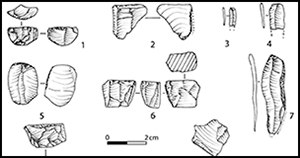Crossref Citations
This article has been cited by the following publications. This list is generated based on data provided by
Crossref.
Skibo, James M.
Malainey, Mary E.
and
Kooiman, Susan M.
2016.
Early pottery in the North American Upper Great Lakes: exploring traces of use.
Antiquity,
Vol. 90,
Issue. 353,
p.
1226.
Cohen, David J.
Bar-Yosef, Ofer
Wu, Xiaohong
Patania, Ilaria
and
Goldberg, Paul
2017.
The emergence of pottery in China: Recent dating of two early pottery cave sites in South China.
Quaternary International,
Vol. 441,
Issue. ,
p.
36.
Nakazawa, Yuichi
and
Akai, Fumito
2017.
Late-Glacial bifacial microblade core technologies in Hokkaido: An implication of human adaptation along the northern Pacific Rim.
Quaternary International,
Vol. 442,
Issue. ,
p.
43.
Chen, Shengqian
and
Yu, Pei-Lin
2017.
Intensified Foraging and the Roots of Farming in China.
Journal of Anthropological Research,
Vol. 73,
Issue. 3,
p.
381.
Kuzmin, Yaroslav V.
2017.
The origins of pottery in East Asia and neighboring regions: An analysis based on radiocarbon data.
Quaternary International,
Vol. 441,
Issue. ,
p.
29.
Kato, Shinji
2017.
The use of lithic raw materials during the Upper Paleolithic in eastern China: A focus on microblade industries.
Quaternary International,
Vol. 442,
Issue. ,
p.
66.
2017.
First Islanders.
p.
267.
Shelach-Lavi, Gideon
and
Tu, Dongdong
2017.
Food, pots and socio-economic transformation: The beginning and intensification of pottery production in North China.
Archaeological Research in Asia,
Vol. 12,
Issue. ,
p.
1.
Maritan, Lara
Iacumin, Paola
Zerboni, Andrea
Venturelli, Giampiero
Dal Sasso, Gregorio
Linseele, Veerle
Talamo, Sahra
Salvatori, Sandro
and
Usai, Donatella
2018.
Fish and salt: The successful recipe of White Nile Mesolithic hunter-gatherer-fishers.
Journal of Archaeological Science,
Vol. 92,
Issue. ,
p.
48.
Song, Yanbo
Sun, Bo
Gao, Yaqi
and
Yi, Hailin
2019.
The environment and subsistence in the lower reaches of the Yellow River around 10,000 BP ——faunal evidence from the bianbiandong cave site in Shandong Province, China.
Quaternary International,
Vol. 521,
Issue. ,
p.
35.
Feng, Yue
2020.
Microblades in MIS2 Central China: Cultural Change and Adaptive Strategies.
PaleoAmerica,
Vol. 6,
Issue. 2,
p.
139.
Zhao, Chao
2020.
The Climate Fluctuation of the 8.2 ka BP Cooling Event and the Transition into Neolithic Lifeways in North China.
Quaternary,
Vol. 3,
Issue. 3,
p.
23.
Guan, Ying
Wang, Xiaomin
Wang, Fagang
Olsen, John W.
Pei, Shuwen
Zhou, Zhenyu
and
Gao, Xing
2020.
Microblade remains from the Xishahe site, North China and their implications for the origin of microblade technology in Northeast Asia.
Quaternary International,
Vol. 535,
Issue. ,
p.
38.
Li, Zhanyang
Doyon, Luc
Fang, Hui
Ledevin, Ronan
Queffelec, Alain
Raguin, Emeline
d’Errico, Francesco
and
Hardy, Karen
2020.
A Paleolithic bird figurine from the Lingjing site, Henan, China.
PLOS ONE,
Vol. 15,
Issue. 6,
p.
e0233370.
Chen, Youcheng
Hou, Guangliang
Gao, Jingyi
E, Chongyi
Chen, Xiaoliang
and
Lancuo, Zhuoma
2021.
Microblade technology and site structure of the Late Mesolithic hunter-gatherers in Donggi-Cona Lake Basin: new implications for human dispersals and interactions in the northeastern Tibetan Plateau during the Holocene.
Quaternary International,
Vol. 574,
Issue. ,
p.
43.
Yi, Mingjie
Gao, Xing
Chen, Fuyou
Pei, Shuwen
and
Wang, Huimin
2021.
Combining sedentism and mobility in the Palaeolithic–Neolithic transition of northern China: the site of Shuidonggou locality 12.
Antiquity,
Vol. 95,
Issue. 380,
p.
292.
Feng, Yue
and
Wang, Youping
2022.
The environmental and cultural contexts of early pottery in south China from the perspective of behavioral diversity in the Terminal Pleistocene.
Quaternary International,
Vol. 608-609,
Issue. ,
p.
33.
Nakazawa, Yuichi
Naganuma, Masaki
and
Tsutsumi, Takashi
2022.
The emergence and transmission of early pottery in the Late-Glacial Japan.
Quaternary International,
Vol. 608-609,
Issue. ,
p.
75.
Jaffe, Yitzchak
2023.
Food in Ancient China.
Fuller, Dorian Q.
and
Champion, Louis
2024.
Early Pottery Technologies among Foragers in Global Perspective.
p.
169.
